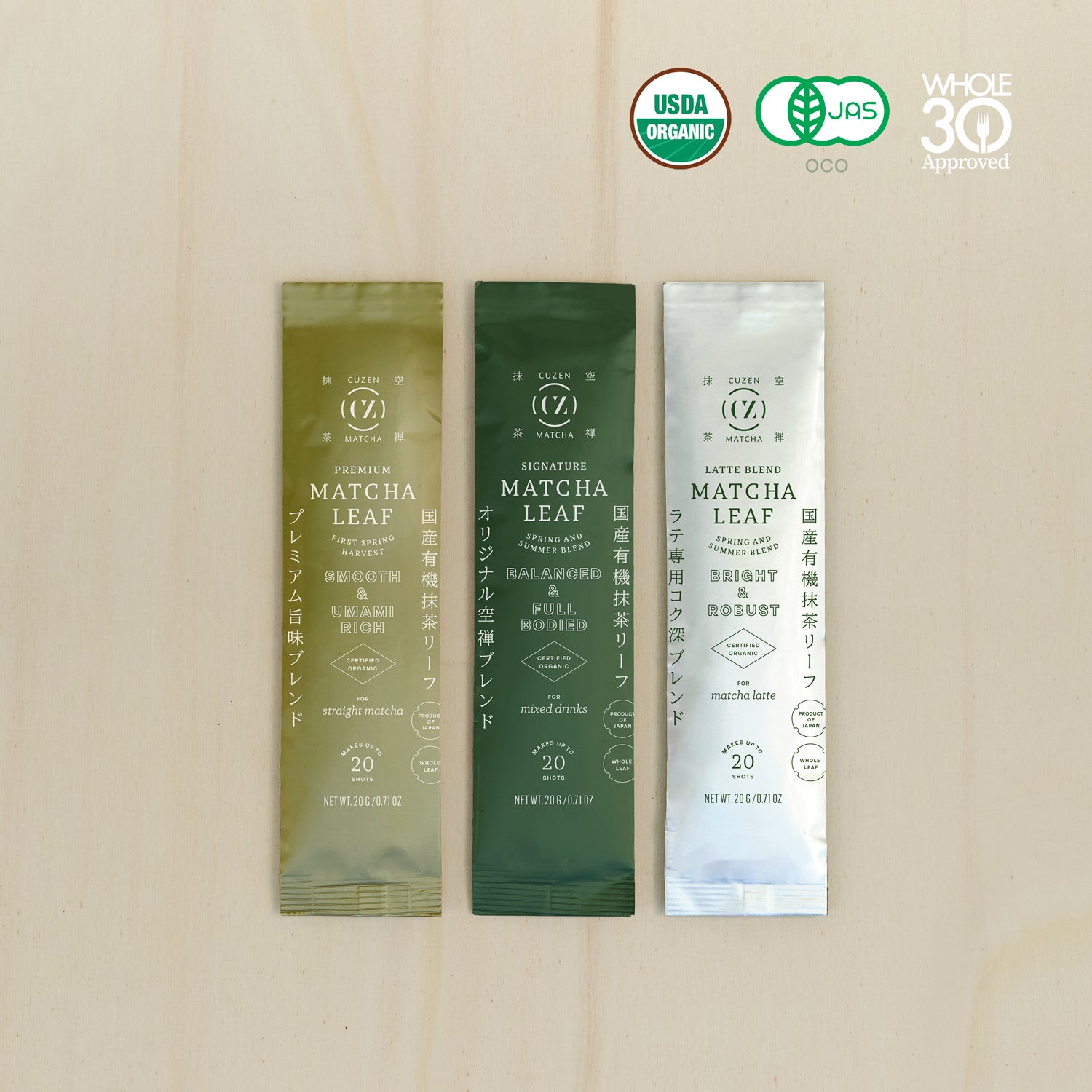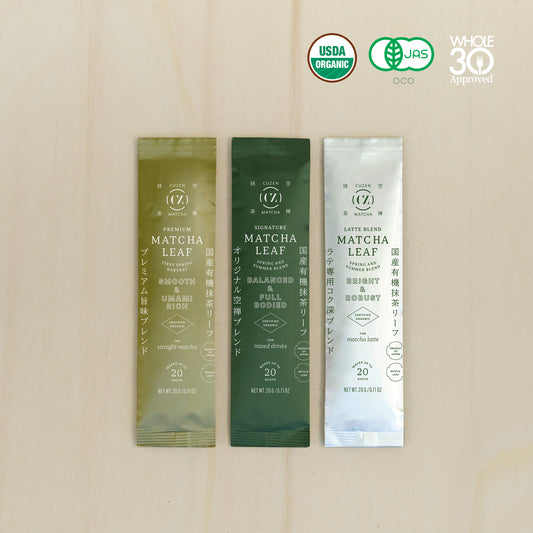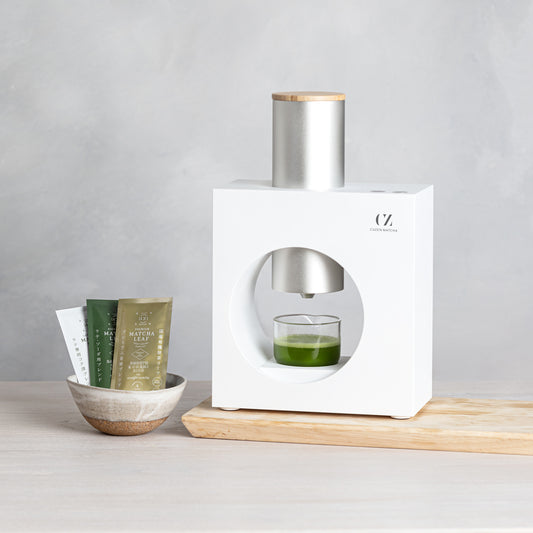

Kagoshima field notes: Organic tea cultivation
Early summer marked the peak of the “nibancha” harvest, or the “second tea” harvest. Cuzen team members visited tea fields and processing facilities nestled deep in the mountains of Kirishima, Kagoshima Prefecture. Accompanied by tea farmers’ stories, this report sheds light on cultivation methods used to grow the most delicious matcha tea leaves.
Contents
- Twenty years of organic cultivation
- Organic cultivation meets quality and productivity
- A sustainable cycle of nature nourishing nature
- Each visit deepens the farm-to-cup connection
1. Twenty years of organic cultivation
Twenty years ago, Cuzen’s farming partners were trailblazers: With strong conviction and a lot of trial and error, they began cultivating organic tea leaves, even before JAS, Japan’s organic certification, had been established. The community reception at the time was challenging and critical due to a limited understanding of organic farming’s significance. Even today, organic tea production remains rare in Japan, accounting for only six percent of the country’s tea-farming output. Thankfully, the farmers are committed and continue to pursue delicious, high-quality tea, without sacrificing the harmony of environment, agriculture and consumer health.
Cultivating umami-rich tea leaves without pesticides requires considerable manual labor and continuous trial and error. “To cease pesticide use means an approximate 20% decrease in harvest due to insect damage. This doesn’t necessarily translate to a 20% increase in price,” the farmer said. “Determining whether we can endure insect damage without resorting to pesticides is essential to continuing organic cultivation,” he explained.
“It takes two to three years to achieve a proper harvest after transitioning to organic cultivation,” the farmer continued. Many farmers, unable to withstand the challenges of organic farming, eventually abandon the practice. “Conversely, continuing beyond three years leads to a decrease in pests, an increase in beneficial insects, the establishment of a healthy tea field-ecosystem, and the stabilization of tea leaf growth.”
The vibrant tea bushes stretch towards the sky, a gorgeous testament to twenty years of commitment and patience to delicious tea and sustainable practices.
2. Organic cultivation meets quality and productivity
“In order to meet demand while practicing organic cultivation, we have to prioritize productivity,” explained the farmer. “We invest approximately three times the effort in observation, which correlates with three times the labor.”
For example, leaves packed with umami components like l-theanine are also appealing to insects. This makes growing pesticide-free, high-quality tencha, the leaves that are ground to become matcha, a bit challenging.
Another example is the high price farmers have to pay for the best plant-shading covers. Our farming partners use silver-colored covers to shield tea fields from the sun, enhancing the tea’s umami content. Though black covers are commonly used for tencha, the combination of a silver front cover and black lining is unique to Cuzen’s farming partners.
“Silver covers reflect the sun, maintaining lower temperatures and preventing heat retention. Lower temperatures result in softer leaf growth,” the farmer told us. And the covers provide more than just ideal texture. “Although silver covers cost more than five times the price of black covers, we have adopted this method to prioritize robust flavor and vivid color.”
From cultivation to processing, the farmers have undertaken various innovations and trials. Despite the obstacles, no compromises are being made in the pursuit of the ideal tea leaf, whether in regard to flavor, quality or productivity.
3. A sustainable cycle of nature nourishing nature
The farmers utilize local resources and natural ingredients to nourish plants without chemicals or materials shipped from far away.
For example, plants are irrigated with sprinklers, which are fed from water pumped up from the reservoir. This not only aids in watering, but also contributes to pest control. “Thanks to the abundant groundwater in the foothills of Mt. Kirishima, we've dug wells and have been utilizing our own water source for irrigation.”
Their approach for feeding the soil goes beyond simply using organic compound fertilizers. They also create unique, in-house compost blends, incorporating fertilizers like fish scraps and rapeseed. “Compost, which is indispensable for soil preparation, is a forward-looking process which considers the next six months of the farming cycle,” explained the farmer. “Nitrogen is crucial for fertilizers. Agriculture is a science!”
4. Each visit deepens the farm-to-cup connection
While working in the scorching heat, the staff's vibrant smiles leave a lasting impression. In the office, staff members are welcomed like family. The love and attention given to the tea plants seems to flow into the familial atmosphere, as everyone moves through their day, fulfilling each careful function of the tea-making process. After visiting the tea fields and witnessing the producers' dedication, a cup of matcha at home becomes even more delightful.
Keep an eye out for our next field report on tea processing.
Related products
-
Organic Matcha Leaf packets
Regular price From $30.00 NZDRegular priceUnit price / per$30.00 NZDsale From $30.00 NZD -
Matcha Maker Starter Kit
Regular price $518.00 NZDRegular priceUnit price / per -
Whisking Cup
Regular price $26.00 NZDRegular priceUnit price / per -
Perfect Matcha Latte Cup (Set of two)
Regular price $191.00 NZDRegular priceUnit price / per














